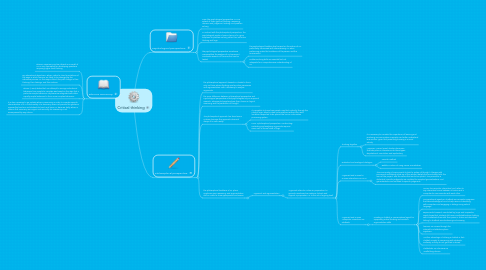
1. Bloom’s Taxonomy
1.1. Bloom’s Taxonomy can be utilised as a model of CT or as a framework for developing questions requiring higher level thinking
1.2. By ‘educational objectives’, Bloom refers to clear formulations of the ways in which learners are likely to be changed by the educative process, or ‘the ways in which they will change in their thinking, their feelings, and their actions’
1.3. Bloom (1956a) states that ‘our attempt to arrange educational behaviors from simple to complex was based on the idea that a particular simple behaviour may become integrated with other equally simple behaviors to form more complex behaviors’
1.4. It is also necessary to go outside Bloom’s Taxonomy in order to consider specific characteristics of CT. Unfortunately, The taxonomy does not provide the guidance required by teachers and students to teach and learn CT, because firstly Bloom's ideas in the Taxonomy are vague, and secondly, his Taxonomy is not accompanied by any criteria
2. Psychological perspective:
2.1. From the psychological perspective, CT is a subset of three types of thinking: reasoning, decision and judgement making, and problem solving
2.2. In contrast with the philosophical perspective, the psychological points of view in terms of CT give emphasis to problem solving rather than reflective thinking and logic
2.3. the psychological perspective sometimes oversimplifies the analysis of CT because it constrains research of theories that can be tested
2.3.1. the psychological tradition has focused on the nature of CT, particularly ‘concerned with characterizing CT when performing under the limitations of the person and the environment
2.3.2. Problem solving skills are essential but not adequate for a comprehensive understanding of CT
3. Philosophical perspective
3.1. the philosophical approach towards CT tends to focus only on those whose thinking involves clear persuasion and argumentation, with a tendency to analyse arguments
3.2. the main difference between Philosophical perspective and Psychological perspective is that psychologists rely on empirical research, whereas philosophers base their claims on logical reasoning and the perfection of thought
3.3. The philosophical approach has faced some criticism because this approach does not always fit in with reality
3.3.1. it is possible to know how people may think critically through the rules of logic, albeit in ideal circumstances without the usual limitations expected to be placed the human information processing system.
3.3.2. From a philosophical perspective, constructing, evaluating and analysing arguments requires some sort of formal rules of logic
3.4. the philosophical traditions of CT place emphasis upon reasoning, and argumentative skills in order to draw appropriate conclusions.
3.4.1. Argument and argumentation
3.4.1.1. Argument refers to a claim or proposition, to grounds mentioned as evidence to back and support a proposition, or to the act of arguing itself
3.4.1.1.1. Thinking together
3.4.1.1.2. Dialectical and Dialogical dialogue:
3.4.1.1.3. Argument and Human to Human Interactions via CMC
3.4.1.1.4. Argument and Human -Computer Ineractions via Chatbots

